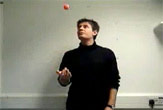Study Reveals How Magic Works

Scientists are figuring out how magicians fool our brains in research that also helps uncover how our mind actually works.
A great deal of what scientists now understand about how the human visual system works stems from research into our susceptibility to optical illusions.
"It made sense to look at magicians to advance knowledge of human cognition, since magicians have been working on figuring out how certain principles of psychology work for hundreds of years," said researcher Gustav Kuhn at the University of Durham in England, a cognitive psychologist who has also performed magic the past couple decades.
"Magicians really have this ability to distort your perceptions, to get people to perceive things that never happened, just like a visual illusion," he added.
The researchers looked into a magic trick called the "vanishing ball," in which a ball apparently disappears in midair. It's done by faking a throw while keeping the ball secretly palmed in the magician's hand.
Kuhn videotaped himself performing two versions of the illusion. In the "pro-illusion" version, on the fake throw, his gaze and head followed an imaginary ball moving upwards. In the "anti-illusion" version, Kuhn's eyes stayed on the hand concealing the ball [video].
Roughly two-thirds of volunteers watching the pro-illusion version on television had a vivid recollection of the ball leaving the top of the screen. "Often they claimed someone at the top of the screen caught the ball," Kuhn told LiveScience. In comparison, only a third of the people viewing the anti-illusion version experienced that illusion.
Get the world’s most fascinating discoveries delivered straight to your inbox.
Kuhn and his colleagues measured the eye movements of volunteers during the experiment. Surprisingly, they found that when people believed they saw the ball vanish, most claimed they spent their entire time looking at the ball, yet most actually glanced at the magician's face prior to following the ball to help them perceive the ball's location.
"Even though people claimed they were looking at the ball, what you find is that they spend a lot of time looking at the face. While their eye movements weren't fooled by where the ball was, their perception was. It reveals how important social cues are in influencing perception," Kuhn said.
"As we are looking at the world, we have this impression that what we see is the real world. What this tells us is the way we see the world is more strongly dominated by how we perceive it to be rather than what it actually is," Kuhn added. "Even though the ball never left the hand, the reason people saw it leave is because they expected the ball to leave the hand. It's the beliefs about what should happen that override the actual visual input."
In the future, the researchers plan to investigate how other magic tricks fool the brain. Kuhn and his colleagues will report their findings in the Nov. 21 issue of the journal Current Biology.
- Video: See How the Ball Disappears
- Creepy Experiment Exposes Paranoia and Sense of Alien Control
- The Most Popular Myths in Science
- Top 10 Mysteries of the Mind
- Video: How to Levitate



